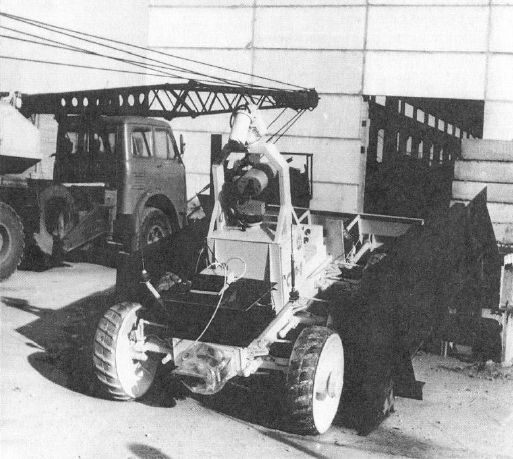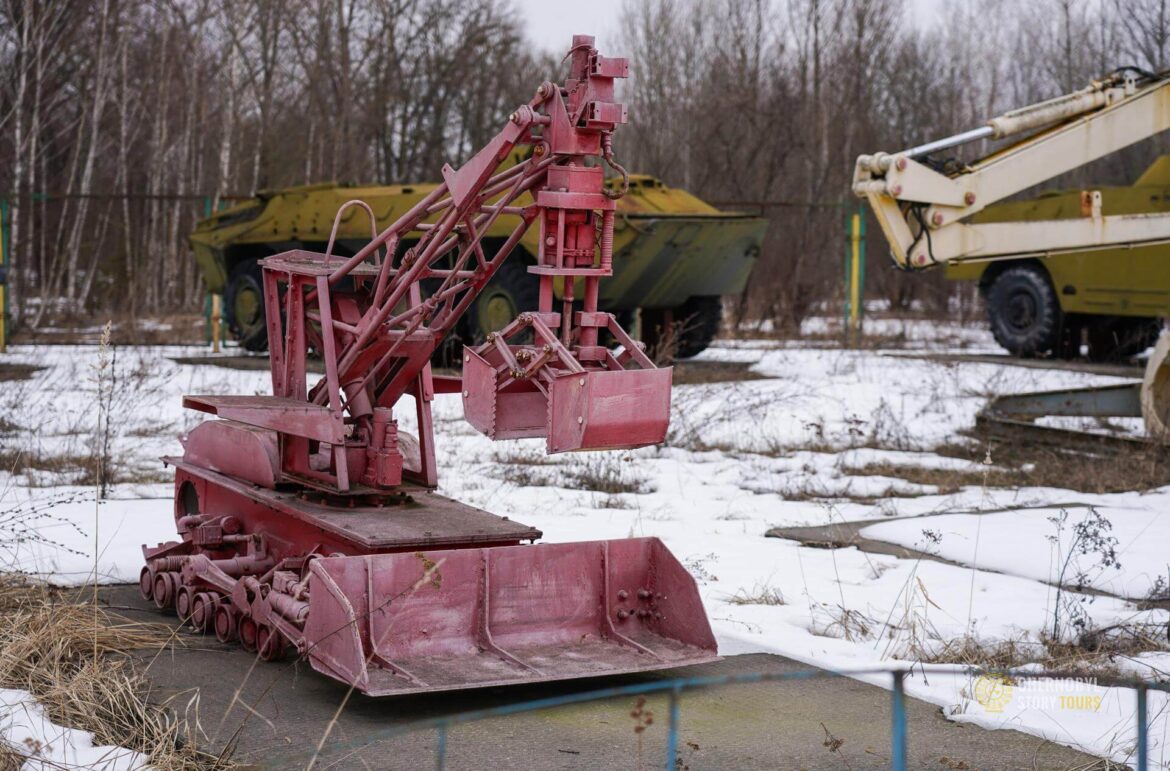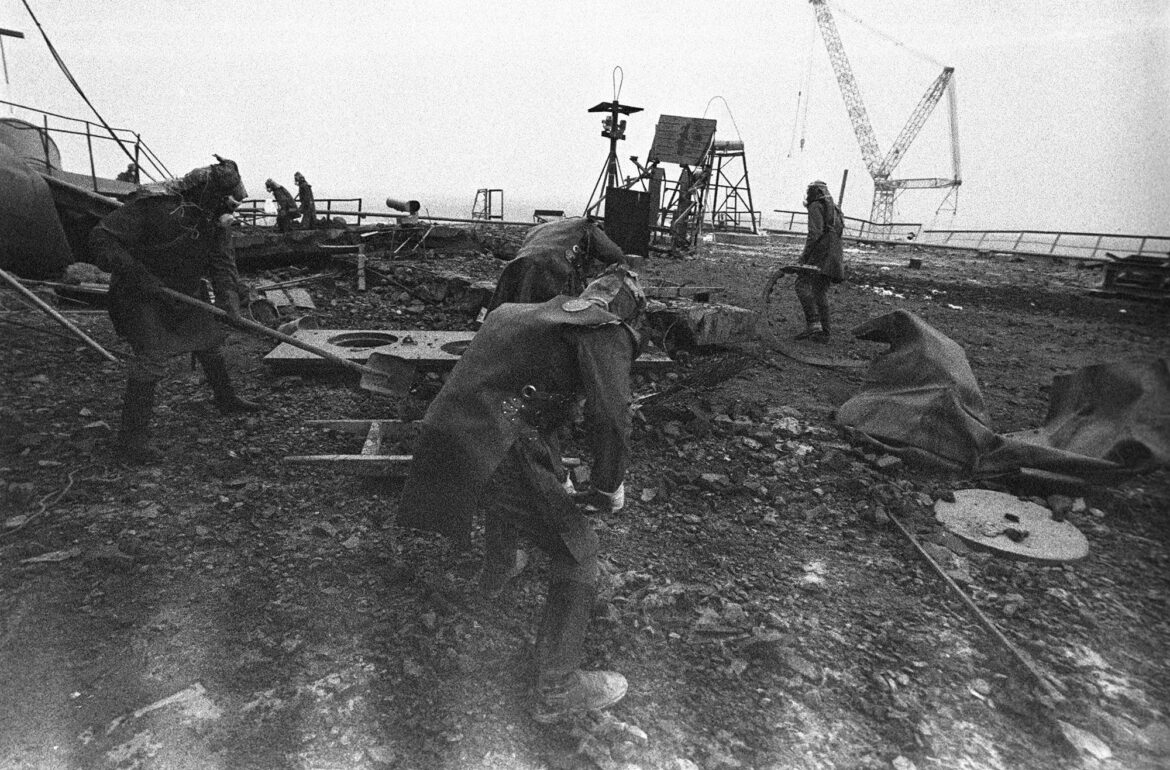
Autobots Assemble: Humans and Robots Unite in Chernobyl
The Chernobyl disaster was a monumental challenge for both humans and machines. Why do we mention machines? Mechanical robots were deployed to assist with the clean-up efforts of the reactor`s roof, although they faced significant difficulties. Obviously they were used because of the high radiation levels, which posed a grave danger to human workers.
STR but not a Dodge

STR-1 robot that cleaned Chernobyl roof
One such robot was the STR-1, a modified Soviet lunar rover, which played a vital role in removing debris from the reactor’s roof.
The robot was powered by two silver-zinc batteries. Initially, the delivery of robots to the roof was carried out by German cranes “Liebherr”. After an emergency situation with the crane and its breakdown, MI-8 helicopters with external suspension took over the delivery. The robot was placed in a special transport cradle, and with the help of a hook lock, it was attached to the helicopter cable. After the terrible MI-8 accident in October 1986 (the helicopter’s tail rotor got caught on the ropes of the Demag CC 8000 crane), flights over the Chernobyl Nuclear Power Plant were prohibited. As a result, the time spent by personnel on roof structures increased (reconnaissance, designation of landing points, etc.).
Another example was the Mobot-CH, a remote-controlled robot provided by West Germany.
The robot is built on a tracked chassis, equipped with a bucket-dozer and a grab mounted on a boom-manipulator, as well as equipment for conducting radiation reconnaissance. Control and power supply were carried out via a cable.
The robots participated in cleaning the roof of the third block of the nuclear power plant from radioactive debris. In this zone, radiation reached up to 10,000 roentgens/hour.
Mobot-Ch-HV-2, virtually without human physical labor in remote-controlled mode, performed the following volume of work:
- clearing debris;
- cutting dry pipes using devices with cord charges;
- removal of highly active radiation sources;
- surface preparation (installing beacons and laying formwork from sandbags) for concreting the roof.

Mobot-Ch-HV-2 nowadays
Batman’s Nemesis Gets a Robotic Upgrade
In 1976, a robotic complex was developed in the research laboratory KFA Julich – West Germany, which was intended for use in the nuclear industry and for work in areas with increased radiation levels.
The MF-2 robot was nicknamed “Joker” because it was initially considered a trump card or an ace up the sleeve for the Chernobyl cleanup operation. The robot was designed for use in high-radiation environments and was expected to be effective in handling the dangerous debris on the reactor’s roof. However, the robot faced issues with its cable control system and the limited operating range, which ultimately led to its limited effectiveness in the cleanup operation. The nickname “Joker” reflects the initially high expectations and the hope that the robot would play a significant role in the disaster response.
MF-3 still had one really weak point. Due to the fact that the machine was controlled using a console on a cable control with a length of only 100 meters, the robot would endanger the life of the operator, who had to be in high radiation fields while controlling the machine. And the cable control of the robot itself was inefficient because the cable constantly got tangled in heaps of debris and rubble on the roof of the station. As a result, despite such advantages as low weight, mobility, and compactness, the robot did not work on the roof of the Chernobyl Nuclear Power Plant for very long.
The Human Factor: The Bio Robots of Chernobyl

Liquidators cleaning the roof after explosion (Photo by Igor Kostin)
With mechanical robots falling short in the face of radiation, the brave individuals who became known as “bio robots” stepped up. These biological robots were soldiers and civilian volunteers who worked in short, intense shifts to manually remove radioactive debris from the reactor’s roof and surrounding areas.
The term “bio robot” emerged due to their ability to complete tasks that machines could not. They wore improvised lead suits and used shovels to clear the debris, facing life-threatening radiation levels. The consequences of their actions were severe, with many suffering from radiation sickness and long-term health issues.
Real Stories vs. HBO’s Chernobyl: How Do They Compare?
The HBO series “Chernobyl” introduced a new generation of viewers to the story of the disaster, including the brave bio robots who risked their lives. The series portrayed the events in a dramatic fashion, though it’s worth comparing the real stories with the fictionalized account.
For instance, the series highlighted the bio robots working on the reactor’s roof, accurately reflecting the extreme conditions they faced. However, the show took some creative liberties with the story, such as combining multiple real-life characters into one or exaggerating specific events for dramatic effect.
In conclusion, the Chernobyl disaster demonstrated the importance of both mechanical and human robots in managing nuclear catastrophes. While mechanical robots faced limitations due to radiation, they paved the way for more advanced technology. The brave bio robots, on the other hand, made significant sacrifices, enduring unimaginable conditions to help mitigate the consequences of the disaster. By comparing the real stories with the fictionalized account presented in HBO’s “Chernobyl,” we can appreciate the courage and determination shown by all those involved in the face of adversity.
Several robots took part in the Chernobyl disaster cleanup. Here is a list of some of the notable robots and their detailed characteristics:
- STR-1 Robot
- Also known as the “Soviet Moon Rover” or “Lunokhod”
- Originally designed for lunar exploration
- Tread-driven, remote-controlled vehicle
- Adapted for use in the Chernobyl cleanup to remove radioactive debris
- Faced challenges due to the intense radiation, which caused malfunctions in its electronics
- Mobot-CH Robot
- Provided by West Germany
- Remote-controlled vehicle with a manipulator arm
- Designed for the removal of debris from the reactor’s roof and surroundings
- Equipped with cameras for remote monitoring
- Like the STR-1, the Mobot-CH faced issues with the high radiation levels, causing its electronics to fail
- German Police Robot
- Also provided by West Germany
- Remote-controlled, tread-driven vehicle
- Used for cleaning up debris and monitoring radiation levels
- Similar to the Mobot-CH in terms of functionality and limitations
- M-28 “Bolshoi” Robot
- Soviet remote-controlled robot
- Built for handling and transporting radioactive materials
- Used in the initial stages of the cleanup
- Encountered difficulties due to high radiation levels
- “Joker” Robot
- Developed after the Chernobyl disaster
- Designed to withstand high radiation levels
- Remote-controlled device used for inspecting the interior of the reactor and collecting samples
- Provided valuable information to researchers about the conditions inside the reactor
While these robots played a crucial role in the Chernobyl disaster cleanup efforts, they faced significant challenges due to the intense radiation levels. The experiences with these robots led to valuable lessons for the development of more advanced, radiation-resistant robots for future use in nuclear disaster management.
Real Stories vs. HBO’s Chernobyl: Explain differences of real story and filmed moments of cleaning reactors roof
HBO’s “Chernobyl” miniseries offered a dramatic and emotional portrayal of the events surrounding the Chernobyl disaster, including the cleanup of the reactor’s roof. While the show managed to capture the dangerous and heroic efforts of those involved, it took some creative liberties when presenting the real story. Here are some differences between the actual events and their depiction in the miniseries:
- The Roof Cleanup Sequence:
- Real story: The cleanup of the reactor’s roof involved multiple teams working in shifts over several months. The teams consisted of bio robots, liquidators, and military personnel, who used shovels to remove radioactive debris and graphite pieces.
- HBO’s Chernobyl: The roof cleanup scene in the series is condensed for dramatic effect, making it appear as if the operation was completed in a much shorter time than it took in reality.
- The Radiation Suits:
- Real story: The bio robots and other workers were provided with improvised lead-lined suits to protect them from radiation. Some workers also wore homemade protective gear made from materials such as lead sheets or other metals. The level of protection varied, and many workers still suffered from radiation exposure.
- HBO’s Chernobyl: The show presents the workers wearing consistent radiation suits, which were not an accurate representation of the various improvised protective gear used by the actual workers.
- The Number of Workers:
- Real story: Thousands of workers were involved in the cleanup efforts, with many of them working on the reactor’s roof.
- HBO’s Chernobyl: The miniseries presents a smaller number of workers in the roof cleanup scenes, giving the impression that fewer individuals were involved in the operation.
- The Representation of Workers:
- Real story: The bio robots and other workers were a mix of soldiers, firefighters, miners, and other civilian volunteers who took part in the cleanup efforts.
- HBO’s Chernobyl: The show focuses on a few central characters, which might lead viewers to believe that the efforts were carried out by a smaller group of individuals. The series also tends to portray the workers as victims rather than emphasizing their courage and determination.
In summary, while HBO’s “Chernobyl” captured the essence of the dangerous and heroic efforts during the reactor’s roof cleanup, it took some creative liberties to present a more dramatic and condensed version of events. By comparing the real story with the filmed moments, we can appreciate the immense challenges faced by the thousands of workers who risked their lives to mitigate the consequences of the disaster.
- - Hostomel
- - Irpin
- - Bucha
- - Romanivka
- - Borodyanka
















Total comments: 0